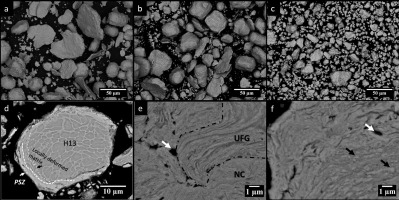当前位置:
X-MOL 学术
›
Mater. Des.
›
论文详情
Our official English website, www.x-mol.net, welcomes your
feedback! (Note: you will need to create a separate account there.)
H13–partially stabilized zirconia nanocomposites fabricated by high-energy mechanical milling and selective laser melting
Materials & Design ( IF 7.6 ) Pub Date : 2018-05-01 , DOI: 10.1016/j.matdes.2018.03.017 Faraz Deirmina , Bandar AlMangour , Dariusz Grzesiak , Massimo Pellizzari
Materials & Design ( IF 7.6 ) Pub Date : 2018-05-01 , DOI: 10.1016/j.matdes.2018.03.017 Faraz Deirmina , Bandar AlMangour , Dariusz Grzesiak , Massimo Pellizzari

|
Abstract This work demonstrated the feasibility of producing partially stabilized zirconia (PSZ)-reinforced AISI H13 steel composites through mechanical milling (MM) and selective laser melting (SLM). The effects of the energy of MM and SLM energy density on the density, microstructure, phases, and microhardness were investigated. Increasing the energy density (η) generally enhanced densification. However, high energy density and increased thermal stresses led to more spherical pores and thermal microcracks. All samples in the as-built condition showed a large amount of retained austenite (RA), which decreased with decreasing energy density. PSZ particles segregated under all processing conditions due to different densities and thermal conductivities of the matrix and reinforcements. Large, string-like areas of segregated PSZ exhibited cracks and debonding in SLM-processed low-energy MM composite powders, whereas SLM-processed high-energy MM powders exhibited smaller segregated PSZ agglomerates with different morphology; most of the PSZ areas were crack-free and well bonded to the matrix. A limited interfacial reaction layer formed in the H13–PSZ composites. High-energy MM composite powders formed parts with higher relative densities and microhardness than low-energy MM powders. Considerable metastable tetragonal ZrO2 formed in all composites, suggesting the potential transformation toughening effect of PSZ to increase the composite's fracture toughness.
中文翻译:

H13-通过高能机械研磨和选择性激光熔化制备的部分稳定的氧化锆纳米复合材料
摘要 这项工作证明了通过机械铣削 (MM) 和选择性激光熔化 (SLM) 生产部分稳定的氧化锆 (PSZ) 增强 AISI H13 钢复合材料的可行性。研究了 MM 能量和 SLM 能量密度对密度、显微组织、相和显微硬度的影响。增加能量密度 (η) 通常会增强致密化。然而,高能量密度和增加的热应力导致更多的球形孔和热微裂纹。在竣工条件下的所有样品都显示出大量残余奥氏体 (RA),其随着能量密度的降低而减少。由于基体和增强材料的不同密度和热导率,PSZ 颗粒在所有加工条件下都会发生分离。大,在 SLM 处理的低能 MM 复合粉末中,分离 PSZ 的线状区域表现出裂纹和脱粘,而 SLM 处理的高能 MM 粉末表现出较小的分离 PSZ 团聚体,具有不同的形态;大多数 PSZ 区域无裂纹且与基体结合良好。在 H13-PSZ 复合材料中形成有限的界面反应层。与低能 MM 粉末相比,高能 MM 复合粉末形成的零件具有更高的相对密度和显微硬度。在所有复合材料中形成了相当多的亚稳态四方 ZrO2,表明 PSZ 具有潜在的相变增韧作用,可提高复合材料的断裂韧性。大多数 PSZ 区域无裂纹且与基体结合良好。在 H13-PSZ 复合材料中形成有限的界面反应层。与低能 MM 粉末相比,高能 MM 复合粉末形成的零件具有更高的相对密度和显微硬度。在所有复合材料中形成了相当多的亚稳态四方 ZrO2,表明 PSZ 具有潜在的相变增韧作用,可提高复合材料的断裂韧性。大多数 PSZ 区域无裂纹且与基体结合良好。在 H13-PSZ 复合材料中形成有限的界面反应层。与低能 MM 粉末相比,高能 MM 复合粉末形成的零件具有更高的相对密度和显微硬度。在所有复合材料中形成了相当多的亚稳态四方 ZrO2,表明 PSZ 具有潜在的相变增韧作用,可提高复合材料的断裂韧性。
更新日期:2018-05-01
中文翻译:

H13-通过高能机械研磨和选择性激光熔化制备的部分稳定的氧化锆纳米复合材料
摘要 这项工作证明了通过机械铣削 (MM) 和选择性激光熔化 (SLM) 生产部分稳定的氧化锆 (PSZ) 增强 AISI H13 钢复合材料的可行性。研究了 MM 能量和 SLM 能量密度对密度、显微组织、相和显微硬度的影响。增加能量密度 (η) 通常会增强致密化。然而,高能量密度和增加的热应力导致更多的球形孔和热微裂纹。在竣工条件下的所有样品都显示出大量残余奥氏体 (RA),其随着能量密度的降低而减少。由于基体和增强材料的不同密度和热导率,PSZ 颗粒在所有加工条件下都会发生分离。大,在 SLM 处理的低能 MM 复合粉末中,分离 PSZ 的线状区域表现出裂纹和脱粘,而 SLM 处理的高能 MM 粉末表现出较小的分离 PSZ 团聚体,具有不同的形态;大多数 PSZ 区域无裂纹且与基体结合良好。在 H13-PSZ 复合材料中形成有限的界面反应层。与低能 MM 粉末相比,高能 MM 复合粉末形成的零件具有更高的相对密度和显微硬度。在所有复合材料中形成了相当多的亚稳态四方 ZrO2,表明 PSZ 具有潜在的相变增韧作用,可提高复合材料的断裂韧性。大多数 PSZ 区域无裂纹且与基体结合良好。在 H13-PSZ 复合材料中形成有限的界面反应层。与低能 MM 粉末相比,高能 MM 复合粉末形成的零件具有更高的相对密度和显微硬度。在所有复合材料中形成了相当多的亚稳态四方 ZrO2,表明 PSZ 具有潜在的相变增韧作用,可提高复合材料的断裂韧性。大多数 PSZ 区域无裂纹且与基体结合良好。在 H13-PSZ 复合材料中形成有限的界面反应层。与低能 MM 粉末相比,高能 MM 复合粉末形成的零件具有更高的相对密度和显微硬度。在所有复合材料中形成了相当多的亚稳态四方 ZrO2,表明 PSZ 具有潜在的相变增韧作用,可提高复合材料的断裂韧性。











































 京公网安备 11010802027423号
京公网安备 11010802027423号